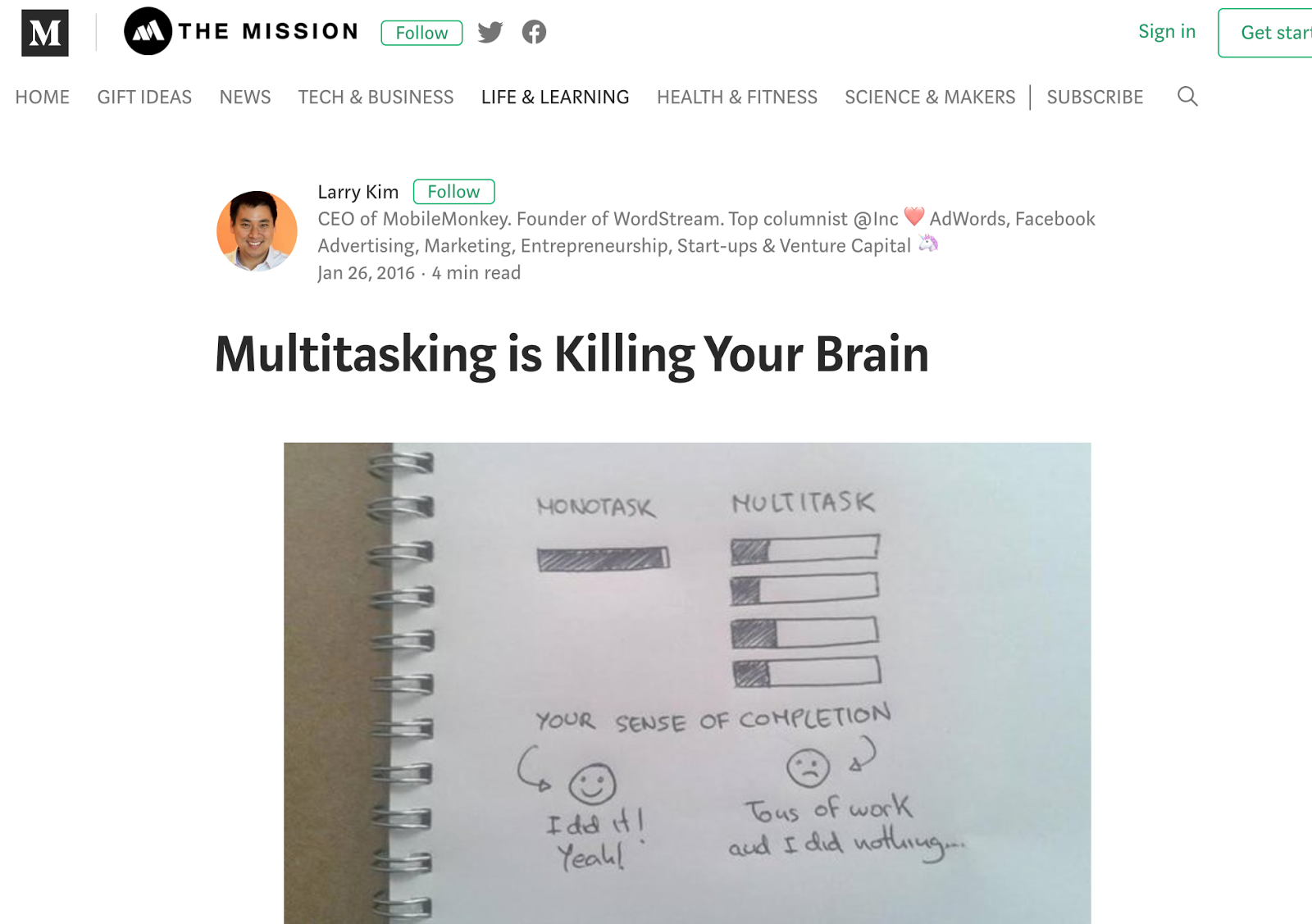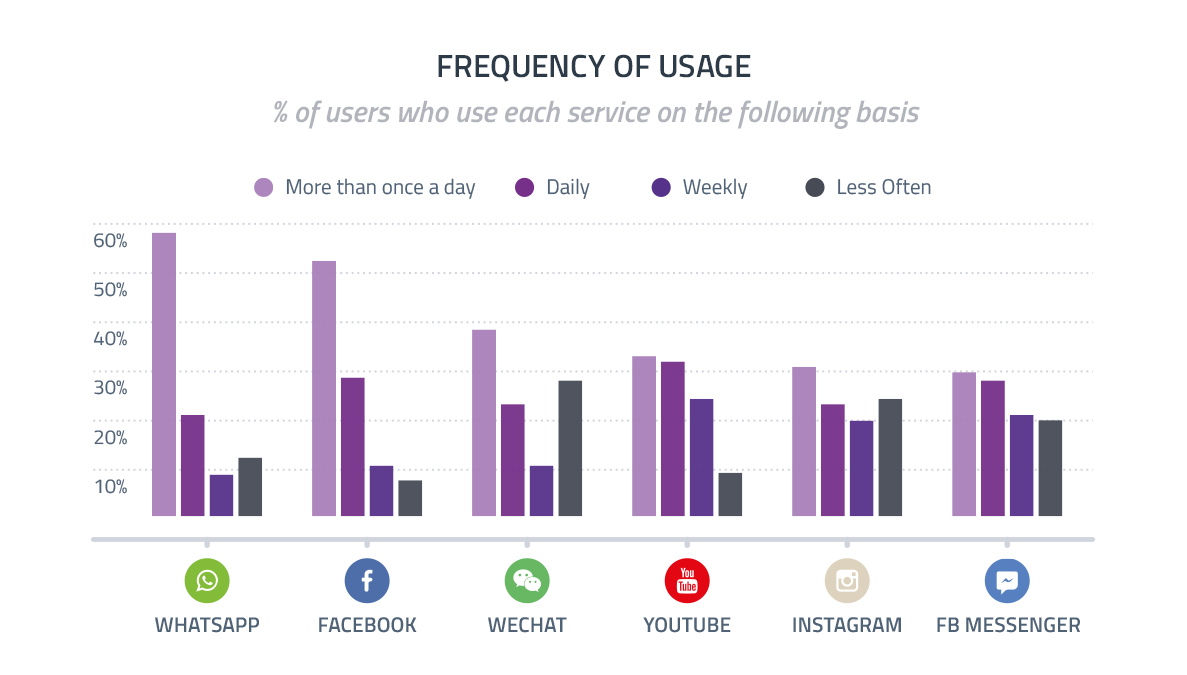
What is Social Media Marketing?

Social Media Marketing, or SMM, is a form of internet marketing that involves creating and sharing content on social media networks to achieve marketing and branding goals.
The objective of social media marketing is to gain Traffic. And this is best achieved by creating content that works well on each platform. Indeed, everyone wants their content to go viral. To do that, the content must be engaging enough to attract visitors.
However, each platform works differently. On one platform, blog content is the master. On another, video content dominates. And on another, pictures win the day.
This implies that each platform requires a slightly different strategy. Otherwise, your social media marketing will fail. Hence, ending up having no shares, no viral content, and no traffic.
But don’t let it scare you. Like I earlier said, you’ll learn everything you need to know about how to set up a social media strategy for each one of them
Why Social Media Marketing?
 The fast shift from a passive web to an interactive web has brought with it a lot of changes that have affected how individuals connect with businesses and also how businesses operate online.
The fast shift from a passive web to an interactive web has brought with it a lot of changes that have affected how individuals connect with businesses and also how businesses operate online.
Let me tell you one truth, you can get ahead in your business if you’re ignoring social media marketing.
With social media marketing, you get closer to your audience than ever before, drive more qualified site traffic, increase the authority of your brand, engage the people who influence your customers’ behavior, and gain the data necessary for insights-based business decisions.
Some key Social Media Marketing Terms:
– Content
Content means any creative element, for example, text, applications, images, archived e-mail messages, data, e-services, audio and video files, and so on. In a social media context, content is whatever you are posting and can in any form. It can be a Facebook status update, a photo on Instagram, a tweet, something to pin on a board on Pinterest, and so on.
– Context
In social media, the word context is the network of intending audience.
Therefore, content should be kept geared towards what users on the network are used to. The content they enjoy engaging with. As an example, you can have a great joke, but if you place it somewhere inside a 3,000+ word blog post, very few people will see it. on the other hand, if you place it on Twitter, that same joke you tweet might become viral.
– Hashtags
A hashtag is simply a keyword phrase, spelled out without spaces, with a pound sign (#) in front of it used to identify messages on a specific topic. e.g #cocacolafans. Almost all social media channels use hashtags to let users describe the topic of their content or mark it as part of current trends.
This way, it makes content easy to be discovered, hence more likely to be shared. You can put hashtags anywhere in your social media posts, whether in the beginning, in the end, or anywhere in between.
– Shares
This is when social media users broadcast web content on a social network to their connections, groups, or specific individuals. Shares are all that matters on social media. They are the currency of the social media world. The more shares, the more people love your content. It’s the best form of engagement that people can have with your content.
Be it impressions, click-through rates, and potential reach, none of these tell you whether people pass on what you have to say. When people engage and interact with your content, that’s good. But, when they share it, that is the time when you celebrate. BuzzSumo. is a tool that helps you measure shares and the overall impact of your content.
– Engagement
Engagement refers to the degree at which people interact with your content in a particular social media network. It can be alike, a recommendation, a comment, or a share. All of these are good, but the shares are where it all lies.
Now that we’ve covered some definitions, let’s take a deep dive into 10 Most Popular Social Media Platforms:
#1 Facebook[ps2id id=’Facebook’ target=”/]

Mark Zuckerberg and his co-founders created facebook in a Boston dorm room in 2004, at first they only made it accessible to Harvard students.
On expansion in 2006, Facebook was open to everyone. Where it exploded. Now it is the giant social media platform out there. It offers marketers the most reliable comprehensive and most targeted ads campaign.
With Facebook Ads, you can target your audience and grow your traffic at a convenient pace.
Facebook gives you a lot of freedom when it comes to content – Images, videos, and text posts all work. You can integrate your content into the platform as much as possible.
For example, instead of just posting a link to a YouTube video, you can upload the video to Facebook’s. In a situation where you want to direct people to a giveaway or landing page, you can publish it as a tab inside your fan page.
Facebook Advertising Option is a go-to for all marketers. The first thing you’ll get to choose when creating a Facebook advertising campaign is the goal of your campaign.
Do you want to drive traffic to your website, drive conversions, promote your Facebook Page, get engagement on your post, or something else? With Facebook Just select the one you want.
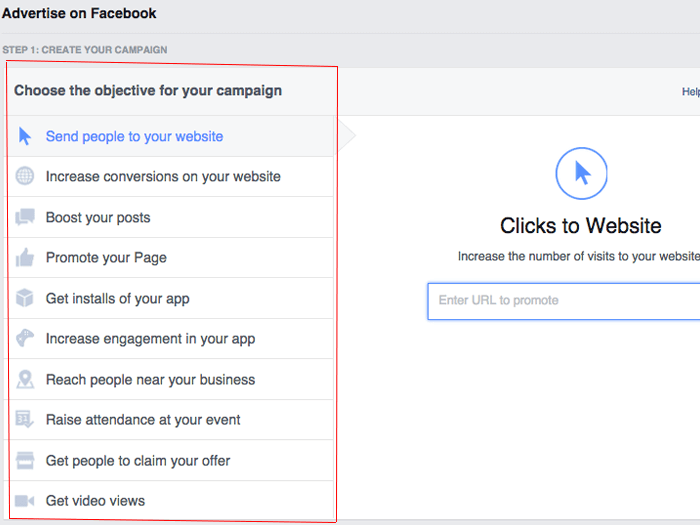
Another good thing about Facebook is the specificity with which you can target your ideal customers. That’s a wildly valuable benefit for any marketer.
You can choose to target people based on their demographics, device, age, interests, and a load of other characteristics. And choose your audience based on their location, age, gender, language, interests, behaviors, and connections.
Many social media platforms will make all these decisions for you. But Facebook puts you in the driver’s seat because they know you’ll likely do the best job of finding your ideal customers. You, after all, know your target market best
Setting Up Your Facebook Marketing Strategy
– Facebook Business Manager
Advertising on Facebook is made easy with the Facebook Business Manager tool. Its a system for managing your advertisements, pages, and fans. It’s quite simple to use.
Go to Facebook Business Manager. Click “Create Account” in the top right-hand corner. Simply enter your business name and click “Continue.” Then enter your name and your business email, then click “Finish.”
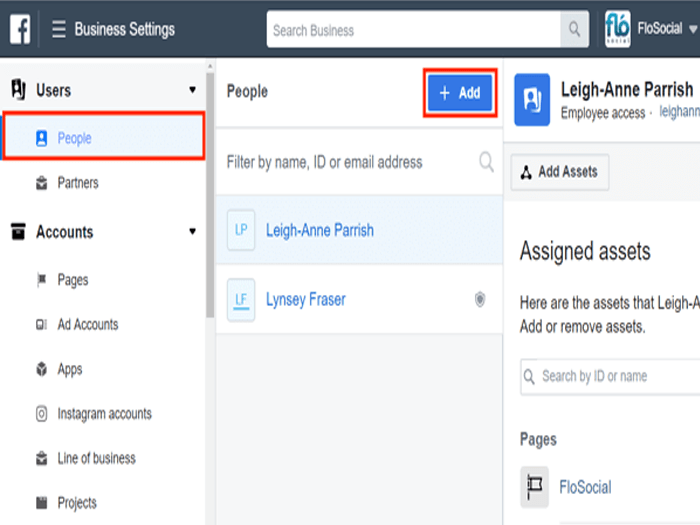
You’ll now see your Business Manager dashboard. Explore its capabilities. This tool is an absolute must use for anyone serious about advertising and marketing on Facebook.
– Facebook Creative
This walk-through focuses on how to use Dynamic Creative via Power Editor. First, navigate to the Ads Manager’s main menu in the top-left corner of your Ads Manager dashboard. Then select All Tools from the drop-down menu and choose Power Editor under the Create & Manage column.
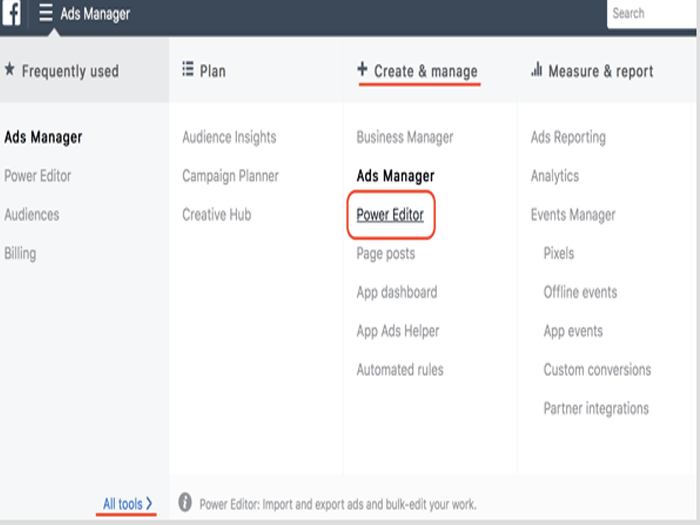
Once Power Editor is open, click Create Campaign. The quick creation workflow then opens in a new pop-up window. Type in a name for your campaign and choose your campaign objective.
Dynamic Creative is currently available only with the Traffic, Conversions, and App Installs objectives. In this example, we chose the Traffic objective. Next, name your ad set and your ad.
Once you’ve done that, click Save to Draft. After your draft campaign appears in Power Editor, click the Ad Set link in the top right. This takes you to the Ad Set level of your campaign where you can enable Dynamic Creative. Click the Dynamic Creative toggle button to turn on the feature.
You’ll then see a pop-up that explains that some ad set and ad settings will be changed that aren’t compatible with the new Dynamic Creative feature.
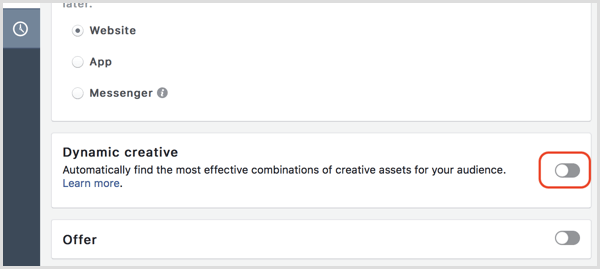
Next, complete your ad set settings by choosing your budget, audience targeting, placement, and optimization. When your ad set is ready to go, click the Add link in the top right to navigate to the Ad level of your campaign. This is where you add your creative asset variations.
At the Ad level, select your Facebook page. Below that, your ad format option is automatically set to a single image/video. (Currently, you can’t use the Carousel ad format with the Dynamic Creative feature.)
Below the creative format, you’ll find the usual Ad level layout with your image/video selection, website destination, display link, text, headline, news feed description, and CTA.
Add buttons appear next to the assets of which you can create multiple variations.
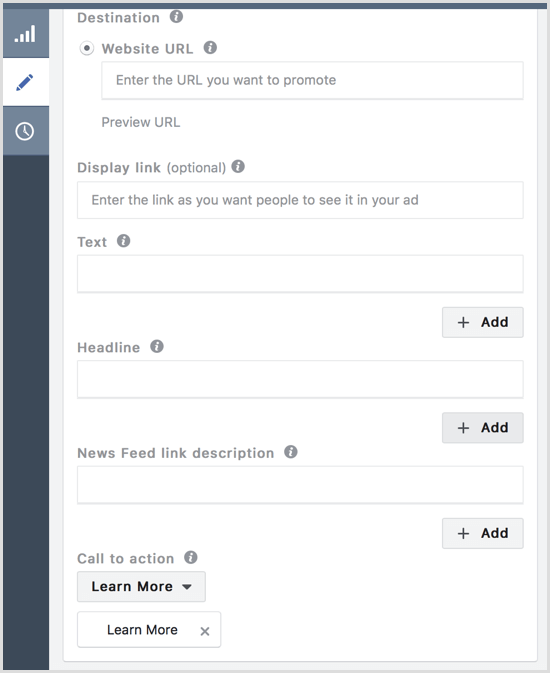
Now select the images or videos you want to test. You can choose images or videos from your library, or upload them directly from your computer.
Facebook lets you add up to 10 images or 10 videos. At the moment, you can’t mix and match the image and video assets.

Now move on to the text variation. After you add your initial copy for the ad, you can add up to four other copy variations by clicking the Add icon. Note that you’re limited to 255 characters, compared to the regular text limit of 2,200 characters. For this reason, the Dynamic Creative feature isn’t suitable for testing long-form copy variations.
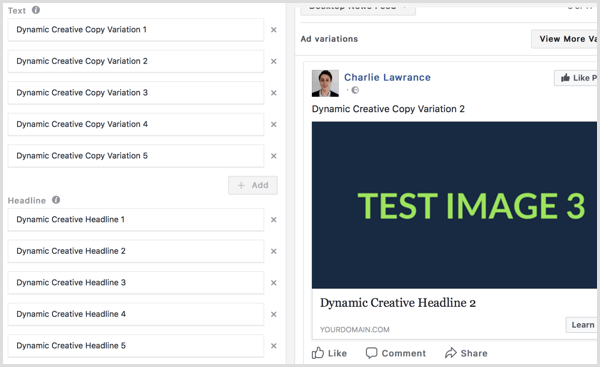
Next, create your link headline variations. Your headline appears under your images or videos in your ad. As with text variations, you can have up to five link headline variations.
Although the character limit is the same as the text limit (255 characters), use concise headlines so they’re not cut off when viewed on mobile devices. Now move on to the news feed link description that appears under your headline. Similar to the text and headline components of your ad, you can add up to five news feed link variations.
Finally, select up to five CTAs from the drop-down list. Make sure the CTAs you test are relevant to the goal of your campaign. For instance, if you’re running an offer ad for an individual product, there’s little point in testing the See Menu or Apply Now CTAs. Just because you can test up to five doesn’t mean you should.
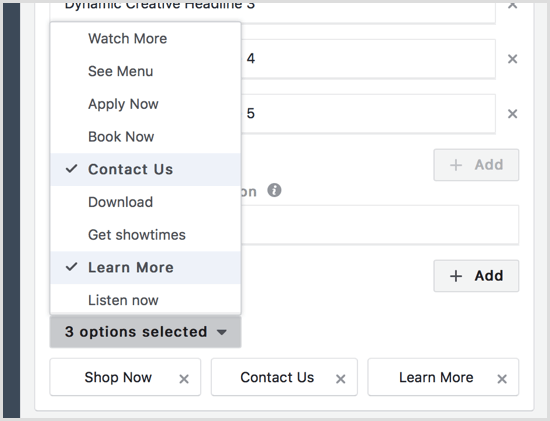
Once you’ve added all of the asset variations you want to test, click the View More Variations button in the top-right corner to preview your ads. In the pop-up window that appears, select any of the asset variations you created to preview the potential ads Facebook will create when randomizing the components.
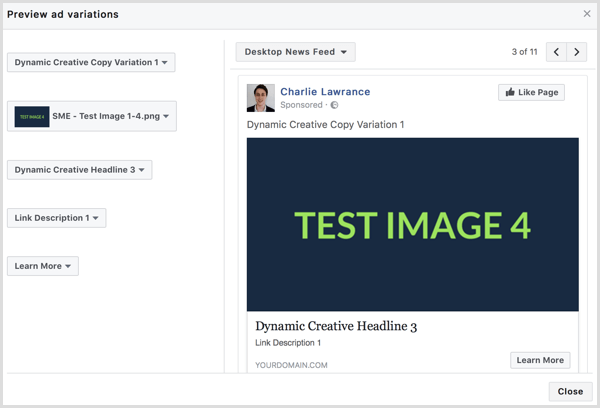
Remember that all of the asset variations you create need to work with one another because Facebook randomizes the variations. You don’t get to choose which variations are put together.
– Lookalike Audiences
What happens when you find the perfect audience to target? You’re raking in traffic and leads like never before. Booyah. But does it have to end there? Finding your perfect advertising audience can take quite some time, so naturally, you want to make the most of it.
Fortunately, when you find your perfect audience, you can leverage it. Facebook allows you to create lookalike audiences.
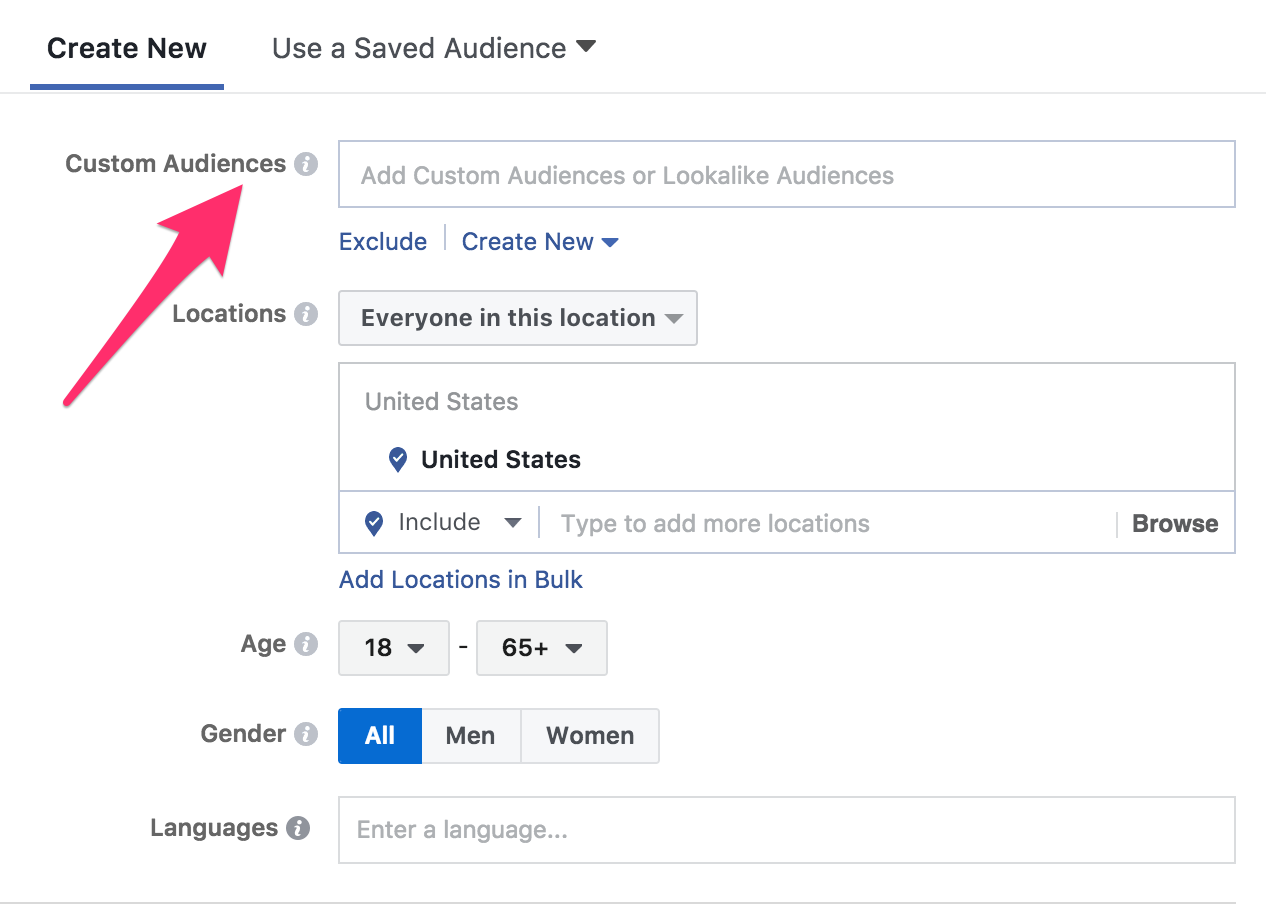
These are audiences that mimic the characteristics of one of your current audiences. That means that if you have an audience that is performing remarkably, you can create a similar audience that should also perform well. Advertisers everywhere flock to this feature because it streamlines the process of finding and expanding your target market. You don’t want to miss out on it.
– Instagram integration
Did you know that when you create an ad on Facebook, you can also run that ad on Instagram by clicking a single button? That’s right. It takes you no extra work. You can simply click the Instagram ad placement button and select “Feed,” “Stories,” or both. If your ad is highly visual and your target market is younger people, then you might want to consider using this automatic integration. It will expand your reach with no extra work.
– Facebook Live
People love Facebook live. They don’t quite love it like they love their families, but pretty darn close. For a while now, marketers have stood in awe of the power of video marketing. At least, they did until the live video came on the scene.
There’s just something about live video that makes it more appealing. Maybe it’s the chance that people will mess up. Maybe it’s the transparency. Maybe it makes us feel more connected. Whatever the reasons, the fact is the same.
People enjoy live video far more than they do traditional videos. That’s particularly true on Facebook. Users spend three times longer watching live videos than they do pre-recorded videos. In other words, live video might be well worth your marketing time and money on Facebook.
It quickly engages people, and they watch it for longer than alternative video content. And since it’s still early in its development, live video isn’t crowded yet. That means that it’s ripe for the taking.
#2 Google+[ps2id id=’Google+’ target=”/]
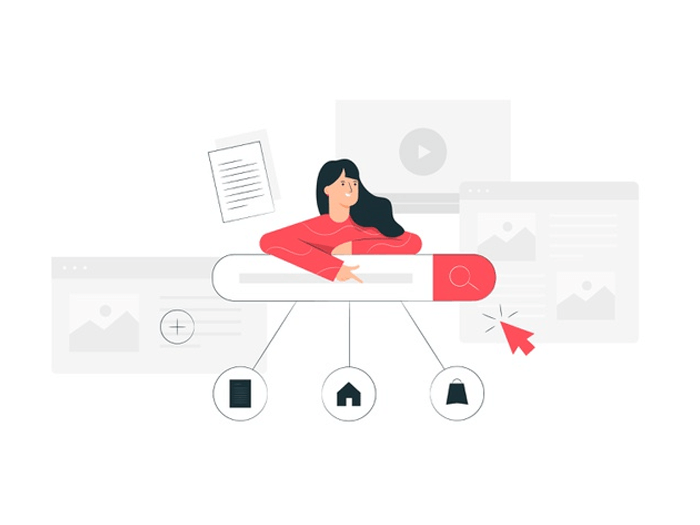
Google+ has only been around since 2011, but can you believe that it has managed to gather 395 million users in that short period? It was Google’s counterattack to Facebook. And even though it surely hasn’t dethroned the king, it’s done fairly well. Out of 2.5 billion Gmail users, around 395 million have activated their Google+ accounts.
However, only 25 million have ever posted on the platform, and only 4-6 million are active on it. The advantage of Google+ is its seamless integration with Gmail. This is because of Google+’s idea of circles. They group everything around their circles.
When you add someone to your network, you can instantly mark them as a friend, colleague or family member. Google+ makes it easy to connect with more people. It recently started allowing you to add people back (in return for them adding you) right from your notification email.
One of Google’s most successful moves was integrating Google Hangouts. Plenty of people use it to host webinars. Similar to Facebook, Google+ allows for a wide variety of posts, including images, videos, and even polls. Even if your main outlet is Facebook, cross-posting to Google+ is an easy win, especially if your circles differ a bit from your Facebook fans. Many online publications consider Google+ to be a failure.
Articles such as “Inside the failure of Google+, a very expensive attempt to unseat Facebook” are relentless in proclaiming that Google+ failed as a social media platform. However, articles like these surely exaggerate the case. Perhaps Google failed for being Google.
Most of us expect bigger wins from such a big company. But if you take the larger picture into account, they still have millions of daily active users. That sure doesn’t seem like a failure. Plus, one of their original intents was to compete with Facebook and automatically integrate with loads of different services.
Take login credentials, for instance. At least in that regard, they are prevalent.
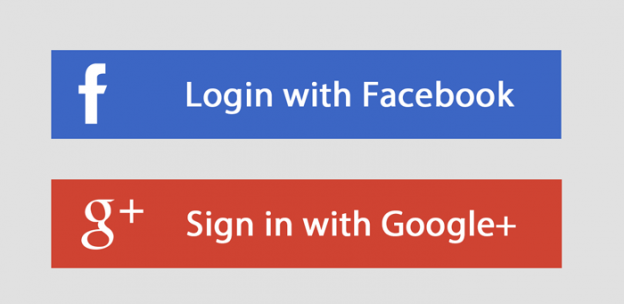
If nothing else, Google and Google+ have succeeded at integrating themselves with other online tools. But, there is something else to keep in mind.
This is a really important part of Google+ and why you might want to consider joining the platform. It can help your SEO. For business information, Google will automatically pull from Google+ business accounts to deliver relevant information to searchers.
Getting on Google+ is probably worth the tiny amount of time you’ll spend doing so to benefit your business’ SEO.
#3 Instagram[ps2id id=’Instagram’ target=”/]

These guys did everything right. They had the perfect app and released it at the perfect time. Within three months of releasing Instagram in the app store, it had reached 1 million users.
Their growth was entirely organic. The app was so good that it dominated the app store charts for months. And, it still does. When the app came out, Apple had just unveiled the iPhone 4. That brought a major leap forward in the quality of pictures that users could take with their smartphones.
Seven years and 800 million users later, the way the app works is almost entirely the same. People post pics, tag friends, insert hashtags, and double-tap to show they like what others share.
It might seem like nothing has happened, but let’s not forget the fact that Facebook acquired Instagram in 2012, only 24 months after they started, for a whopping $1 billion. And in 2015, they rolled out the use of ads for everyone.
Pictures. Instagram is and was always about pictures. Out of all of the big networks, Instagram has the highest engagement rate.
Since liking is so easy (you just double tap on a picture as you scroll through your feed), people tend to do it more on Instagram than on Twitter or Facebook. You can also release 15-second videos on Instagram, but very few accounts do that successfully.
People tend to like and comment more on pictures. However, posting a video on Instagram can certainly work, too. But, if I were to start a new Instagram account from scratch, I’d focus entirely on pictures. Here are a few categories that work well:
- Inspiring quotes
- Questions in text form (they engage your followers)
- Photos of items from luxury brands (like Louis Vuitton handbags, cars from Ferrari, Coca-Cola, etc.)
- Sparsely clothed women (who would have guessed?)
Of course, you must also make use of hashtags, give a call-to-action with each photo, and make sure that you’re using your bio right (it’s your only chance to link back to your site). But, we’ll talk more about that below. You can also focus on Instagram influencer marketing.
– Influencer marketing on Instagram
If there is one social media platform that represents the pinnacle of influencer marketing, it’s Instagram. The reason for that is difficult to understand.
Perhaps it’s because the platform is so visual. Or perhaps it’s because advertisement overloads haven’t yet annoyed the userbase. Or perhaps the influencers enjoy sporting their content more on Instagram than on Facebook, Google+, or the like.
Whatever the case, Instagram is winning big. It’s no surprise, then, that 65% of brands participate in influencer marketing. You might want to consider joining them. And it’s not because you want to give in to the trends of today. It’s because of the influencer marketing trend on Instagram is a powerful one. It’s one that you shouldn’t easily ignore.
– Instagram Stories are stealing users from Snapchat
Instagram Stories is a feature that lets users create a coherent series of pictures, videos, or gifs. And the feature exploded the moment that Instagram created it. In fact, in 2017, the number of people using Instagram Stories flippantly passed the number of users on Snapchat, which is a similar platform. In other words, if you’re going to use Instagram, then you should probably create a Story of your own. Perhaps you should create a Story that shows users behind the scenes of your business or offers special deals.
– How brands are using it today
OK. OK. Instagram is awesome, and it’s growing in power. But all of that raises an important question. How, exactly, are brands using Instagram? What do they use it for? Well, the answer to that question is quite simple.
They are using it for engagement. Instagram is the best social media platform for engagement. It beats Facebook and Twitter. Of course, that doesn’t mean that you can’t sell on the platform and market your products as well.
But trying to push for audience engagement is your best bet. Then, once people learn to love your brand, they’ll buy from you. On Instagram, though, engagement must come first.
#4 YouTube[ps2id id=’YouTube’ target=”/]

Does anyone remember the old player, Google Video? Who knew that it would blow up to 1 billion monthly users in fewer than ten years?
This social network has changed the way we consume video since it has made it easy (streaming is super fast) and free, and it gives us a way to express our opinions instantly (thanks to comments).
Users watch about one billion hours of video on YouTube every single day. That’s 114,000 years! YouTube has spawned entire industries and kick-started thousands of careers. Ten years ago, no one could make a living playing video game. Felix Kjellberg, aka PewDiePie, is one of the biggest earners on the platform, having made 124 million dollars since 2010 (he’s super humble about it).
About 40 million people watch his every move with the joystick, and he has even released his own game. Another, more business-related, example is Robo, a 3D printer startup. They were able to generate $4.8 million in revenue using video ads, including YouTube ads.
Thanks to YouTube, people can now build a nice, small business teaching things, sharing makeup tutorials, doing funny pranks, or sharing their athletic abilities (or lack thereof).
For marketers, it’s a great way to share long-form content with your audience, especially if they’re not avid readers. For example, you could turn your blog posts into video tutorials. Pro tip: Use other social media channels as a gateway to drive your followers to YouTube by giving excerpts, snippets, and previews of your videos.
The little, bite-sized teasers will spark curiosity and make people want to see the whole thing. There are two ways to succeed on YouTube. You can either entertain or teach.
There is no limit to how long your videos can be, and people have published entire courses in the form of a single, 3-hour video. If you’re trying to be funny, you should be funny on all channels. It doesn’t make sense for your brand with a blog about PPC advertising to suddenly make animal jokes on YouTube.
You’d be better off teaching some of your strategies on video. Don’t overcomplicate this. You don’t need high-quality recording equipment or fancy editing.
The chances are good that you are a few steps ahead of most people in your niche, so just get in front of your webcam and start teaching. As Nathan Barry says: Teach everything you know.
– The rise of DIY video filming
With social media, anyone can become a star. And that truth is no different on YouTube. Sure, since YouTube is video-based, it requires a bit of videography knowledge and a bit of the right equipment.
But already, tons of different online phenomena are DIY-ing their way to becoming YouTube sensations. With just a decent light, microphone, and camera, your business can start using YouTube to drive traffic and generate leads. Even your iPhone will do.
– Post-production and editing
It’s not just video filming that the DIYers are taking over. It’s also post-production and editing. Every year it seems, new tools come out that allow people like you to edit your video content with ease.
For editing your video content for YouTube, consider WeVideo. It’s is free and easy to use. With it, you can layer content, cut content, and even add new graphics. What’s not to like? After all, it’s free.
– Video ads
Finally, you might want to consider using video ads on YouTube. They look something like this. Depending on the type of ad you choose to use, viewers will either be able to skip your ad after a few seconds or YouTube will make them watch the entire thing.
Naturally, different strategies will work for different businesses. Don’t be afraid to try different things. A/B test to see what works best and what doesn’t work at all. In the end, your advertisement on YouTube will only be as good as your determination to find out what works. Spend the extra time and money to do so. You won’t regret it.
#5 LinkedIn[ps2id id=’LinkedIn’ target=”/]

LinkedIn is older than Facebook. Reid Hoffman, one of the early members of PayPal, founded it in 2002. But initial growth was slow. On some days, he only had only 20 sign-ups. LinkedIn’s growth never exploded as much as Facebook’s, but they’ve been around for 15 years and have grown to over 467 million members.
The strategy that got them some traction was focusing on what worked well. For example, they gave a lot of attention to their homepage, which accounted for 40% of their sign-ups.
They quickly increased that number to 50% within four months (13,000 more people per month), whereas getting email invitations to increase from 4% to 7% (19,000 more people per month) took two years. What they always had going for them was being profitable very early.
Thanks to premium subscriptions, a paid job board, and a few other freemium options, they were making money after only three years of being in business.
They experienced several key turning points, such as allowing users to import contacts, focusing on the professional San Francisco tech scene, and acquiring and integrating great services like SlideShare and Pulse.
These decisions helped them grow into a 7,600-person company that Microsoft bought for over $26 billion.
On LinkedIn, it’s all about being professional. The casual writing style that’s used to make some blogs, including my own, so popular, doesn’t work as well on LinkedIn.
People are there for one thing only: business. They want to learn about what’s new in their industries, who’s hiring, who’s firing, and how to optimize their performance at work.
A SlideShare about baking muffins won’t do nearly as well as an in-depth company presentation from a tech conference. If your content helps people expand their networks or conduct business in a better way, it has a place on LinkedIn. If not, you might want to focus on other channels first.
– LinkedIn Groups
If you’re familiar with Facebook Groups, then LinkedIn Groups shouldn’t stretch your imagination too far. Just think of Facebook Groups but for business people. LinkedIn Groups are a place for like-minded professionals to gather and discuss topics of interest or establish their expertise.
You might want to consider joining one to establish your business as an expert on certain topics. After all, the more people that believe your business knows what it’s talking about, the more people who will work with you in the future. It’s an easy strategy for making connections and growing your content marketing audience.
– LinkedIn Advertising
As with all social media platforms, you can also use LinkedIn to run your advertisements. And if your business falls into the B2B category, LinkedIn might just be the best place for your advertisements. Marketers rate LinkedIn as the most effective social media platform for B2B companies.
LinkedIn is also the top platform for lead generation by a long shot. Since people on LinkedIn are there to talk business, they also don’t mind interacting with businesses.
That means that your business can get some serious attention on the platform if you play your cards right. And advertisements might just be the way you choose to do that.
#6 Reddit[ps2id id=’Reddit’ target=”/]
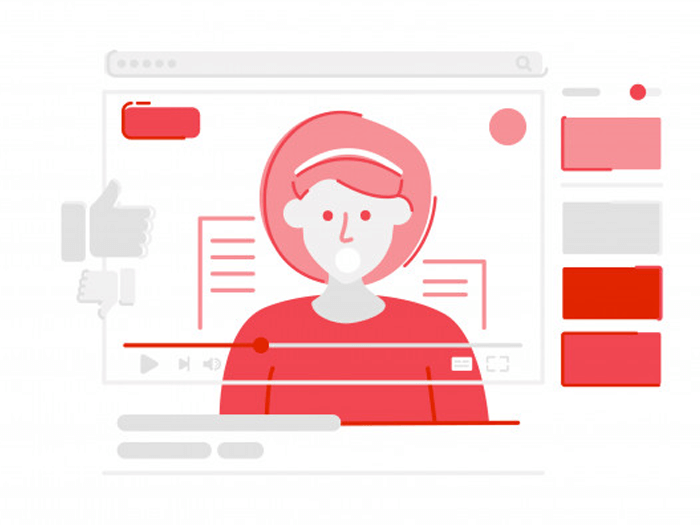
Reddit’s slogan claims that they are the “front page of the Internet,” and they aren’t very far off. With 250 million unique monthly users, Reddit might just live up to its description.
Reddit is another college-originated social media site, and it’s a very special one at that. It focuses entirely on community benefit. Reddit’s users will ferociously attack you for spamming link bait or dumping promotional links on their boards (or subreddits).
But if Redditors like what they see, they can easily drive enough traffic to your site to crash it. You shouldn’t take a Reddit traffic storm lightly. Two key factors that helped Reddit grow to such a massive platform are AMAs (Ask Me Anything) and their voting feature. Users can upvote and downvote entries, links, and comments.
The most popular and helpful submissions always show up on top. Reddit rewards (or punishes) account with karma, which they display separately for links and text posts.
This way, users don’t have to dig through tons of content before finding what’s good. They can see what’s popular right at their first glimpse. The platform took off when celebrities started doing AMAs. During AMAs, Celebrities hang around on the platform for a while and answer user questions live.
People who have done AMA’s include Barack Obama, Arnold Schwarzenegger, Tim Ferriss, David Copperfield, and even Bill Gates.
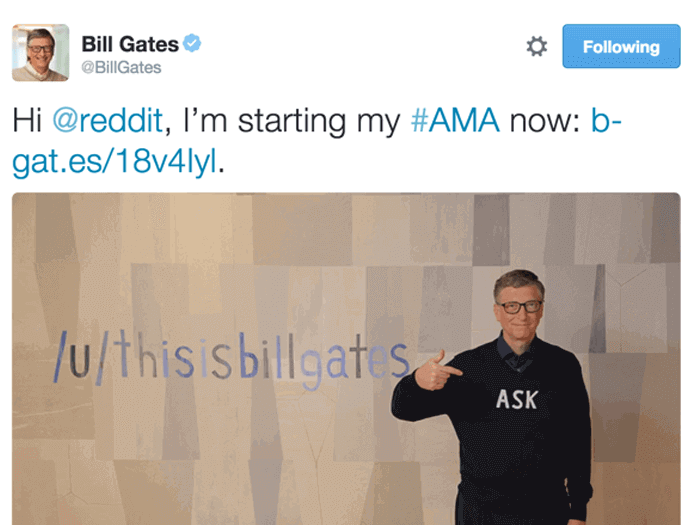
Reddit requires people to post proof that they’re doing an AMA. Reddit is tough to crack. You can’t use it as another distribution channel and just submit a link every time you publish something on your blog.
You have to be present, be communicate, and give value to fellow Redditors without asking for anything first. Submit funny and helpful links for a while just to build up your karma, and then refer back to your content.
But only do so where it’s appropriate. And, be sure to make the links a side note rather than the entire content of the post. For example, the e-commerce brand Findlay was able to generate $28,000 in sales using Reddit correctly.
Reddit marketing fails
Reddit mostly hates marketers. It’s not necessarily the fault of marketers, though. Reddit is just a unique community.
They don’t like people who are too blatant in their marketing, and they don’t like businesses trying to be pushy. For that reason, even some of the top businesses have made massive mistakes on Reddit.
The CEO of a large outdoor gear retail chain started an AMA on Reddit, hoping to generate brand awareness. Here’s what he got instead.

And look at this response.

That’s a bit of a Reddit disaster, huh? So what’s the point? Be careful what you post on Reddit. Take some time to understand the audience before you start using the platform to advertise and market.
Once you do understand Redditors, though, the platform represents a well of marketing potential you won’t be able to pass up.
– Reddit ads
If you don’t want to try and grow an organic following on Reddit, then you can consider simply posting ads on the platform. First, though, you’ll need to determine if Reddit is the right place for your advertisements.
As we already discussed, advertising gone wrong can hurt instead of help your business on Reddit. So make sure that you know what you’re getting yourself into first.
Here’s some help in terms of demographics. The platform consists primarily of males under the age of thirty. And users highly discourage content that is too salty. Is your business a fit for Reddit? If so, then you can create an ad and see how it performs.
Watch it carefully, though, so that users don’t bombard you with hateful comments and hurt your brand image before you’re able to respond. If you’re going to run ads on the platform, then be ready to respond to some serious heat. But if you live through the heat, you could harness some serious potential.
#7 Snapchat[ps2id id=’Snapchat’ target=”/]

I remember downloading this app back in 2012 and thinking, “This is stupid.” I deleted it and didn’t hear about it again until about two years later. I still think it’s stupid, but 28% of America’s millennials don’t.
Snapchat has 178 million daily active users. While the majority of those are girls (about 70%), the boys who share on the platform have one thing in common: They’re young. 71% of the users are under 34 years old. The hacks and spam and naked selfie scandals might easily distract the average adult from the fact that this is one serious platform for marketers.
Though the app has only been around for a few years (since September of 2011), it is already worth around $33 billion (though there is some disagreement amongst sources). If your products are targeting 14-year-old girls and you’re not on Snapchat, you are doing something wrong.
However, even if you’re on the platform, it’s easy to do a lot of wrongs. Since all images and videos disappear after 10 seconds max, the context suggests that all content on the platform is fleeting and short-lived. Naturally, it makes sense to provide content around that same theme.
For example, you could give your audience access to a live event. If you’re giving a talk at a conference, take a few snaps when you’re on stage and share them with your followers. Let them behind the scenes.
Show them the happy hour on Friday at the office, the IPO party, and even how you act when you’re alone at home. You could show them your practice run of the speech, how you screwed up your makeup, or what a cool car picked you up from the airport.
Snapchat is all about sharing those precious moments that we all have so few of in life, so make sure that you use it for just that.
– B2B marketing on Snapchat
Can you market your B2B company on Snapchat? Some people think you can’t. After all, a large portion of the current Snapchat user base consists of those who are teenagers or younger.
But don’t let that young audience deceive you. As the platform finds its footing in the digital world, older populations are flocking to the platform as well.
One entrepreneur uses the platform to offer regular advice to other entrepreneurs. And HubSpot uses it to increase and establish their brand’s personality.
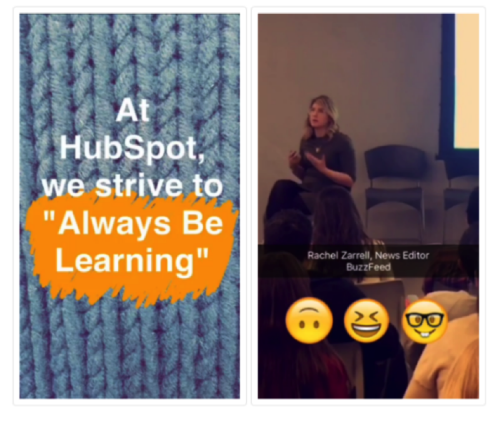
And DocuSign used it to interact with people during a conference. So yes. You definitely can use Snapchat to market your B2B company. Plenty of other businesses are doing it, and you can do it too.
Of course, Snapchat requires a bit more creativity on your part than other platforms. Keep in mind that users can only view their images and videos once.
That should at least partly define the type of content you put out. Plus, that restriction can also work in your favor. Since all your content is temporary, people might be more inclined to view your snaps while they can and fully take in the content. Once they do, it goes away.
#8 Pinterest[ps2id id=’Pinterest’ target=”/]
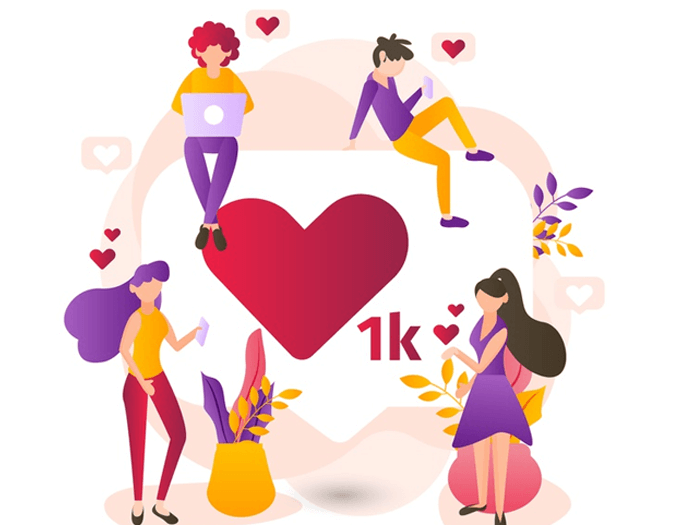
Pinterest is the number one social media platform for marketers who want to target women. 81% of their 150 million monthly active users are female.
You can think of the site as a giant digital scrapbook. Between their closed launch in 2010 and 2012, you needed an invitation to get on the platform, so it’s only been open to the public for five years. Nevertheless, the leads you acquire from Pinterest are high-quality.
And from funding round to funding round, they’ve increased their valuation (which was at $11 billion the last time they solicited investor money).
Even though Pinterest doesn’t yet make any serious money except for a few ads for famous brands, they are one of the top ten most influential social platforms right now.
That is one of the most popular boards on Pinterest. Always, always, always remember that 81% of the audience are women.

They collect, they curate, and they share. Topics like decorations, interior design, cooking, and clothing do extremely well. Due to the nature of the pinboards, Pinterest is also one of the only platforms where images look best when you display them vertically.
Keep in mind that your pics need special formatting to look good on Pinterest.
– Influencer marketing on Pinterest
If Instagram is the god of influencer marketing, then Pinterest is this god’s son (or more appropriately, his daughter). Since Pinterest allows users to market within whatever niché they like, influencers flock to the platform like hotcakes at IHOP.
But that’s a good thing for your business. Since you’re a marketer within a specific niché, you can use those influencers to advertise your product to their existing audiences. Growing your audience takes a ton of time. And maybe, just maybe, you don’t have a ton of time.
In that case, influencer marketing is your answer.
Here’s a Pinterest account that puts out recipes, for instance, with almost four million followers.
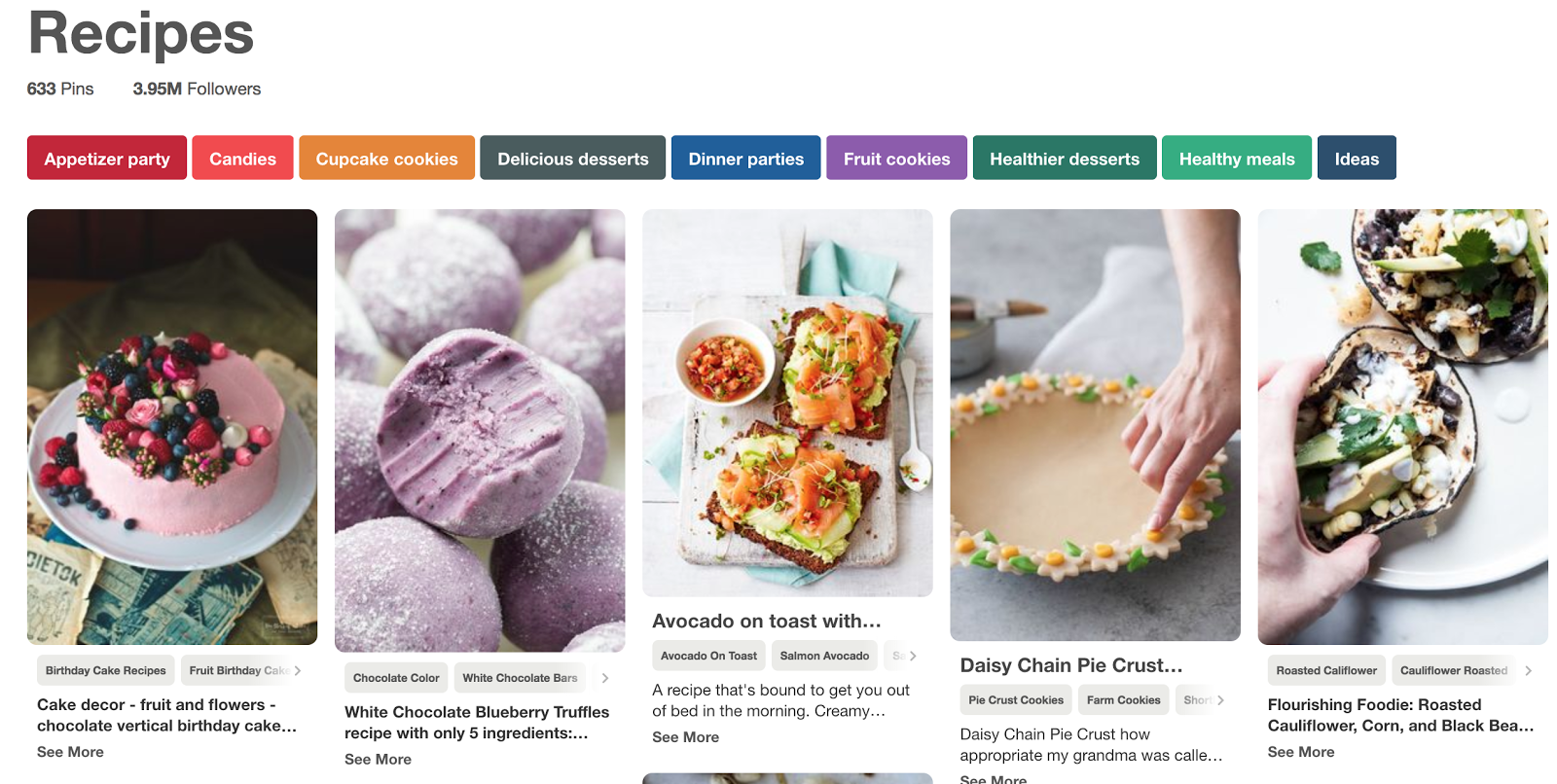
And here’s another influencer who posts about everything from recipes to decorations and fashion.
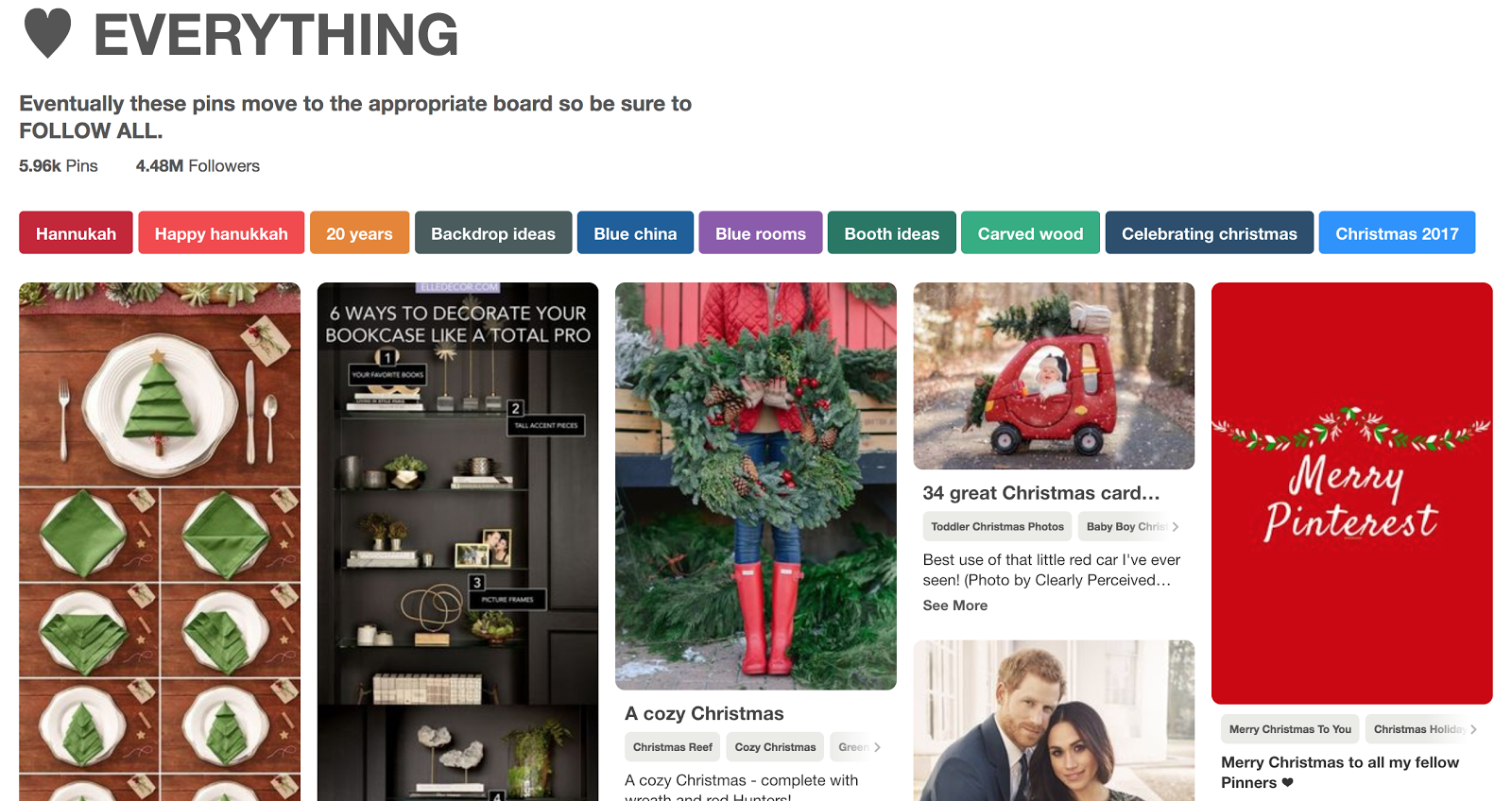
Here’s the best news, though. There’s a niché for everything on Pinterest. That further means that there’s an influencer for everything.
Do you want to market clothing or tiny toy dogs or Harry Potter attire? Believe it or not, there’s a board for that.
– Ads and buy-able pins
Of course, not everyone will want to go through the hassle of finding, talking with, and hiring influencers. Some of you will simply want to run advertisements on the platform and get on with your lives. In that case, remember that the vast majority of people on Pinterest are women.
For some of you, that’s a good thing. For others of you, that’s not such a good thing. However, despite that gender-leaning, Pinterest is a remarkable platform for getting people to buy your products. 93% of users use Pinterest to plan their purchases, and 96% use it gather product information.
And the best part is that the ads fit right into the boards seamlessly. Here’s an ad you probably wouldn’t have noticed if I hadn’t highlighted it. If you have a product for women that’s highly visual and you don’t want to deal with influencers, then Pinterest ads are your solution.
Run them and see how it goes.
#9 Tumblr[ps2id id=’Tumblr’ target=”/]

Huge in some industries and completely unnoticed by others, Tumblr is sort of a mix of a blog, Instagram, and Twitter. The owners call it a microblogging platform.
This platform is primarily useful for curating images. Users can easily reblog and like these images sort of like retweets and favorites.
You can scroll down an infinite feed, which makes it easy to consume. David Karp founded it in 2007, and as of November 2017, Tumblr powers over 375 million blogs. Some of these belong to celebrities like Lady Gaga. Ariana Grande’s Tumblr is popular as well.
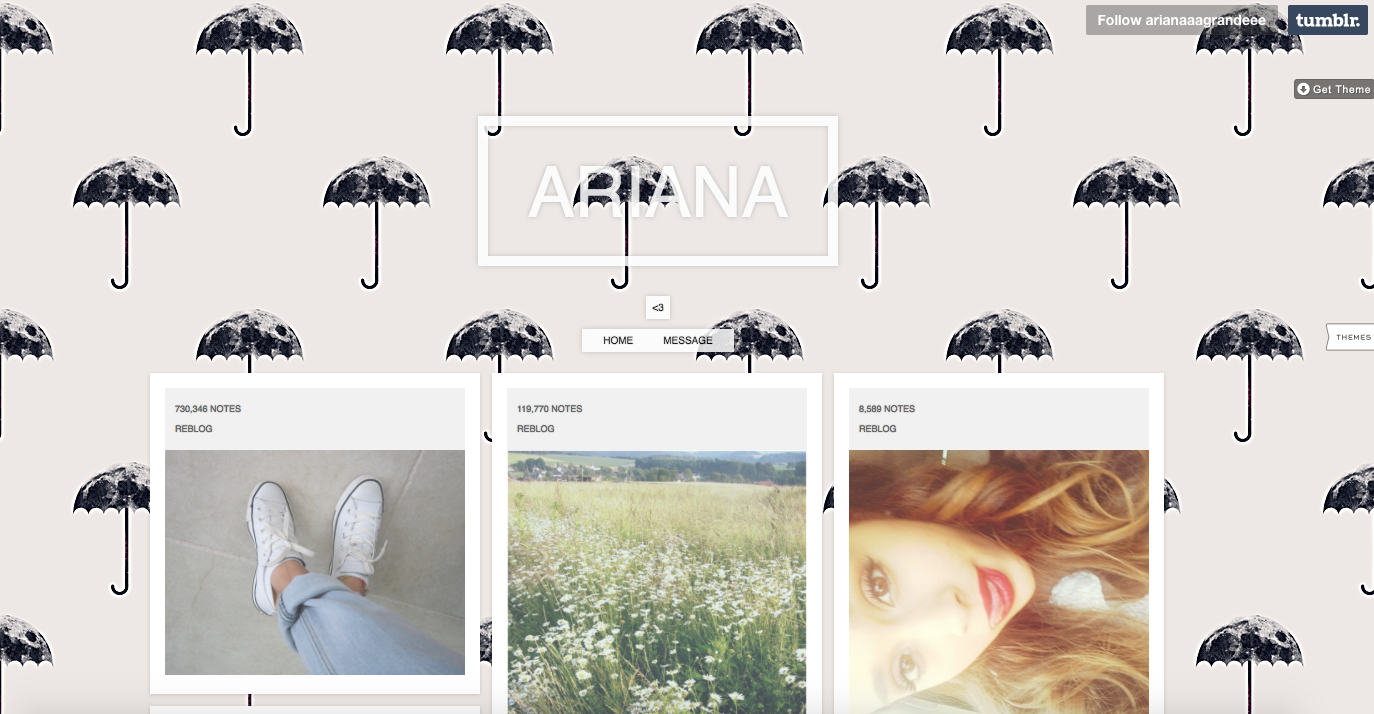
There are even entrepreneurs who took advantage of Tumblr and launched profitable businesses through it. Yahoo bought Tumblr in 2013 for over $1 billion. In 2011, they had only collected about 1/10th of that in funding (around $125 million).
Now, users create over 30 million posts each day, and the site makes money with advertising. The endless scroll feature makes Tumblr naturally good for images. It’s a very visual medium. Designers and photographers often use it to display their portfolios. Fashion brands and bloggers can use it to curate content from their industries.
There’s one type of file, however, that Tumblr is the number #1 platform for GIFs. The animated, moving images are right in between photographs and videos. Most people switch to Instagram for photos, and videos don’t work well on Tumblr since they interrupt your flow (you have to stop, press play, then pause the video again and scroll to the next one).
GIFs are the cross-pollination of the two. Funny memes, animated clips, and short video excerpts make users scroll endlessly and binge-consume the content.
If you’re in fashion, design, photography or other visual industry, be sure to take a very serious look at Tumblr.
– Tumblr audience demographic
The audience on Tumblr is a bit different than any other social media platform. Most of the people are on the platform to have fun. They are there to share funny comics, memes, and gifs.
They aren’t particularly friendly toward marketers, however. But that doesn’t mean that you can’t market on the platform. It simply means you need to be more creative when you’re doing so.
Tumblr is a great place for your marketing strategies to take form. People who use social media spend more time on Tumblr than they even spend on Facebook. That means that your posts and advertisements have a higher chance of the right people seeing them at the right time.
Additionally, the vast majority of Tumblr users are young. Most are somewhere between 18 and 34 years old. While you keep in mind that the users are young, also remember that they’re on Tumblr for entertainment.
They aren’t there to find products, and they aren’t there to hear about your brand message. One company recognized this with their product, the Holy Meme Bible.
They realized that Tumblr loves memes and that the people there would likely respond well to their product. So, for three weeks, they went full-board and marketed their Meme Bible on Tumblr. And what was the result? The made over $200,000 in sales in three short weeks. If you have a product that works for the Tumblr audience, then you’re doing yourself a serious disservice by not using the platform to market your product.
#10 Medium[ps2id id=’Medium’ target=”/]

You’d think by now that there are enough blogging platforms out there. But nope, apparently, there aren’t. Somehow, within five years, Medium grew into one of the largest blogging sites on the web with an Alexa ranking of 328.
A big reason for this success is its sleek and simple design. Ev Williams, one of the co-founders of Twitter, initially launched it in a 2012 closed beta before eventually opening it to the public. Similar to some apps, such as Hemingway, the user interface is incredibly simple.
The difference is that users can press publish directly instead of copying the content to their blog. Before Williams founded Medium, he also created Blogger, which he eventually sold to Google. He has a knack for blogging platforms.
Thanks to its numerous big publications, Medium can be a way to build an entire audience without ever creating your website. Better Humans is a popular one.

The most popular topics are design, startups, marketing, and social or political matters. Context: Since it’s a blog platform, Medium naturally does well with long-form content.
However, posts also shouldn’t be too long. Medium shows the estimated reading time for each post right at the top of them.

If people see that it’ll take 20 minutes to read your post, you’ll scare most of them away. Most users aren’t willing to make such a big-time commitment. 7-minute posts do best, so it makes sense to break up longer articles into a series of posts.
Ali Mese has done exceptionally well on Medium, creating a huge audience from scratch thanks to several posts that have gone viral.

If you have a big following already, you can use it to catapult your articles to the top since the posts that users recommend the most land in the featured stories where most users will see them.
As few as 50-100 recommendations within an hour or two can drive your article right to the front page. Big outlets like Huffington Post, Business Insider, and Entrepreneur often pick up content that has done well on Medium. That gets it additional exposure.
– Medium audience demographic
In December of 2017, Medium received nearly 150 million visits. And the majority of the traffic to the site (nearly 26%) came from the United States. This offers a lot of potentials for you to get yourself and your business in front of new prospects.
Also, keep in mind that the majority of visitors to the site are men with an above-average education. What does this mean for you? Well, if your social media strategy revolves around posting cooking recipes or cat videos, then Medium may not be the right site for you.
Similar to LinkedIn, Medium is ideal for posting more professional content. For example, the most popular tag in 2016 was politics. Now, that doesn’t necessarily mean that you need to post political content. All I’m saying is that the gap between politics and business is a lot smaller than the gap between politics and DIY crafts. Take, for instance, the Marketing and Entrepreneurship section on Medium. It has 146,000 followers.
There’s an audience for this sort of content. In a more niche-specific section like this, you may not attract the attention of as many people as you could on Facebook or a larger social networking site.
But because the following is narrower, you’ll likely get a higher percentage of the right people to interact with you and your brand. So, what’s the verdict: should you use Medium?
If your content is more lighthearted or is likely to appeal to a predominantly female audience, then consider a platform like Pinterest instead. But if the topics you blog about relate to more serious matters, then you have nothing to lose by posting them on Medium. There’s much you could gain.
– Marketing content on Medium
If your content is relevant for Medium users, then using the platform for marketing is a no-brainer. Using the platform to benefit your business will require almost no additional effort.
All you have to do is take blog posts that you’ve already written and reposted them on Medium. Since you still own the rights to the content on Medium, you can do with it as you like.
And it’s an easy way to get additional eyes on all your hard work.
Dave Schools, for instance, experiences a lot of success on the blogging platform. Help Scout also reposts their already-existing blog content. Larry Kim does this as well.
What do you have to lose? You can use Medium to easily get your blog content in front of new eyes, and it won’t take you any extra work to do so. Just copy and paste content from your website, and voilâ! More people see it than before.
#11 Quora[ps2id id=’Quora’ target=”/]

This is another Silicon Valley-based startup. Two former Facebook employees created it in 2009 and made it public in 2010. They thought that Q&A was one of the great formats of the Internet, but up to that point, no one had built a solid platform for it. It turned out that they were right.
With a comparatively low $80 million in funding so far, they have built Quora up to over 190 million users in eight years. Users can ask questions, and if they’re popular, users can re-ask them.
Users can also upvote answers to make sure that quality answers show up first. People have built entire platforms from answering questions on Quora, and some answers boast more than 1 million views.

The startup just implemented advertisements in the middle of 2016, drawing the eyes of marketers all around the digital globe. This platform centers around one thing: questions.
You can get the most out of it by providing quality answers to popular questions that users have re-asked lots of times. Thanks to the voting system, quality answers make it to the top.
And, they usually stay there for a long time. Try to give answers that will still be valid in a year or two or even five. Some of the most popular Quora answers came from years ago.

You can double your benefit from Quora if you use it to come up with content. For example, you could write a blog post that gives a very detailed answer to a popular question. Not only will you have a great blog post then, but you’ll also be able to republish it as the answer to that question.
This will also help you build a reputation as an expert on your topic. If someone likes an answer that they read from you, they’ll often browse through the other answers that you’ve given.
Quora and content marketing
Quora is a great place for establishing yourself as an expert on a certain topic. And that can happen in two different ways. It can happen on Quora or off Quora. Either way, the question-and-answer platform helps. How, you ask, does it help?
Well, first, you can answer your target market’s questions. Imagine, for instance, that you’re a digital marketer and you want to start establishing yourself as an expert in the digital world. You can go to Quora and answer questions like these.
Then, if your answer is remarkable, people will upvote it, making it a winner in the Quora SEO system. But in case that’s not good enough, you can also use Quora to find topics for your blog. After all, your audience has a lot of questions.
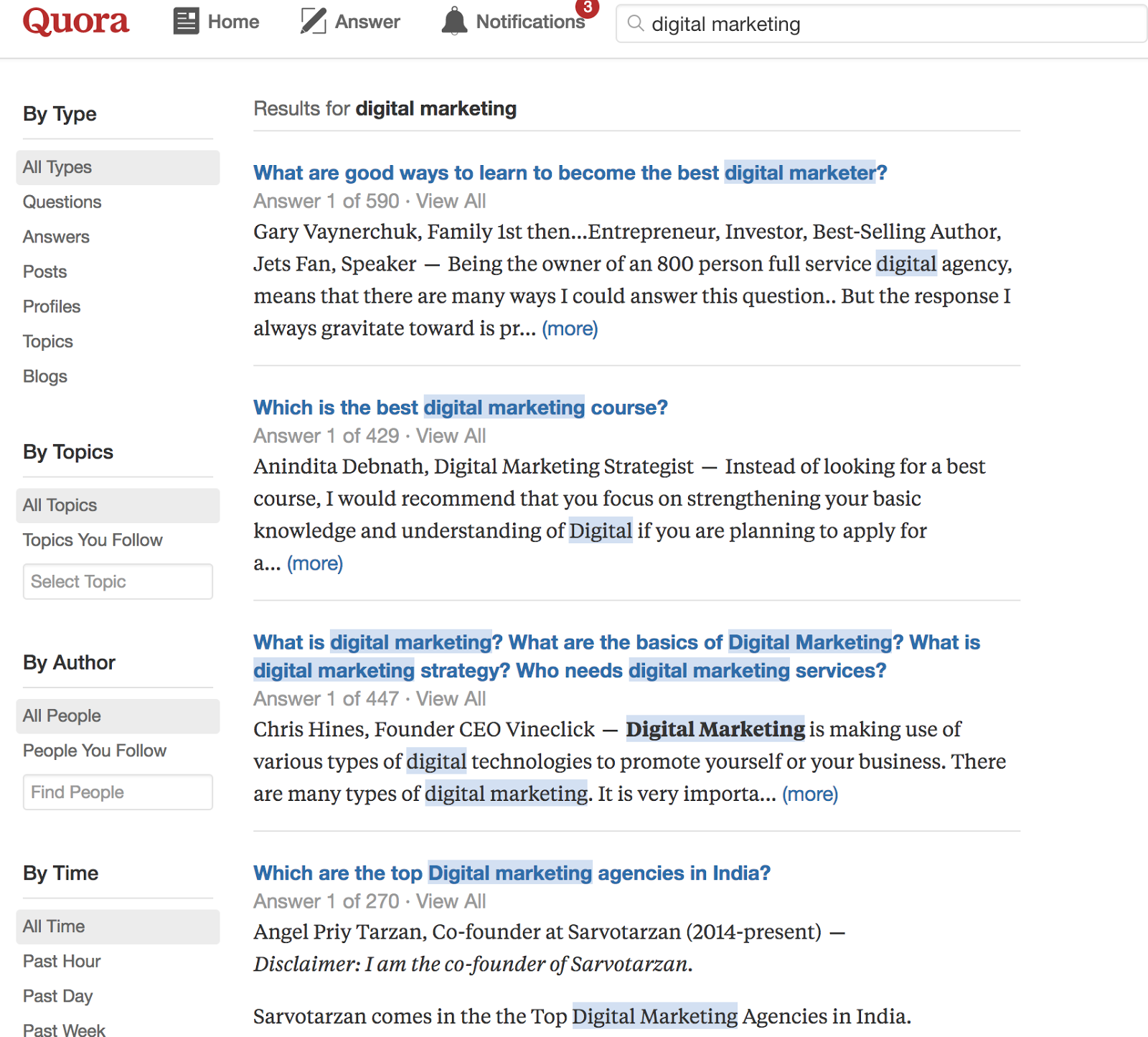
And finding out what those questions are can be seriously tedious. Fortunately, Quora makes it easy. Simply go to Quora and type in your niché. Browse through the questions people are asking. Then, all you have to do is take those same questions and create your website content around them. It’s an easy way to come up with content topics that your audience is interested in digesting.
Boom You Are In
Alright, that was a lot. You now have an overview of the 12 most important social media platforms. But that’s just the tip of the iceberg.
According to Wikipedia, there are over 200 of them. And that number is only growing. So you should establish a social media presence on at least a few of them.
Figure out where your audience is and get active on that platform. You now know how each platform got to where it’s at, what the context of each channel suggests that you do, and you know how to come up with good content for each of them.
Nothing is holding you back. You have the information you need. Will you change your social media marketing strategy? Which platform will you focus your social media strategy on? And, which site will go big next?
Let me know your guesses and answers in the comments.

